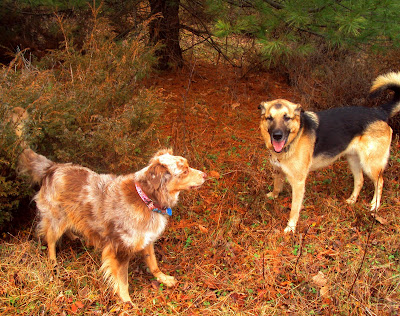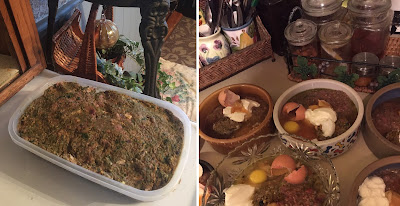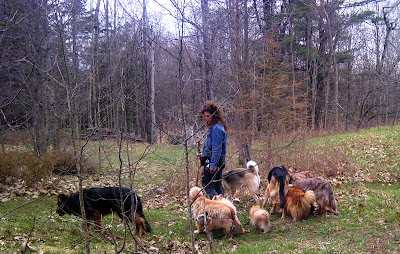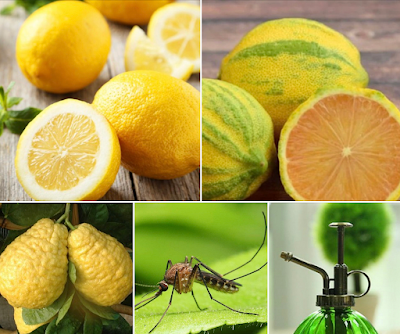A GOOD DOG-TO-DOG MEETING
Your role in a dog-to-dog meeting is to coach and mentor, not to stress and panic!
Teaching your dog good social manners with other dogs starts with training yourself.
STEP ONE
Make sure you are not tense, stressed or anticipating reactive behavior (what you probably think of as aggressive) from your dog. To lead by example you must be without any such emotions. You must be (calm) and have confidence in yourself and in your dog. Your state of calm, confidence will set the framework for your dog’s state. If your thoughts and body language are relaxed and confident you indicate to your dog that you are confident with the situation - this allows your dog to relax and normalize the experience of meeting another dog.
If greetings have not always gone well in the past and you anticipate that this new greeting will also go badly - I assure you, you are right - it will not go well! Dogs are very sensitive and use their senses (sight, scent, sound) more keenly and consciously than people do. They read stress & emotion in people before a person is even aware of how they themselves feel. They do look at our face to read our reactions. A little tension in a persons shoulder, clinching of a hand, tightness of the lips, narrowing or widening of the eyes, change in breathing, sweating. They know what you are thinking, what you are feeling! The affect of our state-of-being on our dogs is profound. If you anticipate trouble you create trouble! You create tension and sometimes all that is required to trigger reactivity in your dog is a little nervousness. This tells your dog that you are not in control and therefore it cannot trust you or the situation. Your dog becomes insecure and nervous, even fearful. This is the trigger for reactivity - what you see as aggression.
So train yourself to control your thoughts, your emotion and direct your focus. Only then can you properly support your dog. Remember you communicate with your state-of-mind, and hence your body…not just by the words or tone you use to speak.
STEP TWO
Coach your dog. If your dog growls disagree - touch your dog with the tip of your fingers, quickly and firmly and say 'no' immediately upon hearing the growl. You have seconds in which to 'disagree' - if you wait any longer your dog will not understand what you are disagreeing with. When you disagree always be calm, confident - never angry, frustrated, tense, etc. Otherwise you will be leading by example - but it is the wrong example!
When we attempt to direct our dogs and we are in an emotional state - we lose our audience. Dogs do not like hypocrisy any more than humans do. In fact I believe they are even less accepting of it! Dogs will respect those people who have earned their respect. Other people will receive various levels of respect or not from your dog according to how the people behave.
STEP THREE
Make sure that your dog is calm before it approaches another dog. If your dog is reactive, stop, disagree (touch if you need to reinforce, and say 'no' firmly) and tell your dog what you would like it to do instead (for example - sit).
A very big mistake I see people making (and I teach my client’s not to make!) is to give half of a direction. It is all very well to tell your dog ‘no’ or ‘stop’ but you also need to tell your dog what you would like it to do instead. I always say a full direction to your dog should consist of several steps: a) attention, b) direction, c) correction if required and d) follow through as required.
So get your dogs attention first (you can say ‘shh!, ‘hey’, snap your fingers or touch), and let them know what you do not want them to do, then let them know what you do want them to do. If they do not get it right don’t be angry or frustrated, instead be patient. Remember you are working…your job is to coach and mentor, lead by example.
Once your dog is calm, you can move forward and approach the other dog...always set the framework...if dog is not calm stop...get him to calm and then move forward.
STEP FOUR
If your dog is too rough or too insistent (pushy, dominating) when greeting another dog, you need to disagree with your dog’s behavior. For instance your dog places his paws on the other dogs back, tries to mount the other dog, etc. Touch your dog and say 'no' and then say 'gentle'. Touch gets his attention, 'no' to indicate the behavior is not appropriate and 'gentle' to provide the right direction. This is coaching/mentoring.
STEP FIVE
Encourage your dog to use its noise to greet another dog. A dog’s sense of smell is acute. In its natural state, dogs greet each other by smelling each other - not by jumping all over each other in an excited state. Excited greetings occur because the human has taught the dog that greeting (a human or another dog) requires excitement. This is not a dog’s way. It is a human’s way. To teach this type of greeting de-normalizes the experience for a dog. Make greeting normal.
USE THIS TECHNIQUE TO MODERATE PLAY TOO!
You can use these same techniques if your dog plays too roughly with another dog. Go up to the dogs, be calm but deliberately confident - get their attention (as described above), direct, correct and follow through.
So the next time you have the opportunity to introduce your dog to another dog - remember don’t anticipate the worst, instead create the best!
Teaching your dog good social manners with other dogs starts with training yourself.
STEP ONE
Make sure you are not tense, stressed or anticipating reactive behavior (what you probably think of as aggressive) from your dog. To lead by example you must be without any such emotions. You must be (calm) and have confidence in yourself and in your dog. Your state of calm, confidence will set the framework for your dog’s state. If your thoughts and body language are relaxed and confident you indicate to your dog that you are confident with the situation - this allows your dog to relax and normalize the experience of meeting another dog.
If greetings have not always gone well in the past and you anticipate that this new greeting will also go badly - I assure you, you are right - it will not go well! Dogs are very sensitive and use their senses (sight, scent, sound) more keenly and consciously than people do. They read stress & emotion in people before a person is even aware of how they themselves feel. They do look at our face to read our reactions. A little tension in a persons shoulder, clinching of a hand, tightness of the lips, narrowing or widening of the eyes, change in breathing, sweating. They know what you are thinking, what you are feeling! The affect of our state-of-being on our dogs is profound. If you anticipate trouble you create trouble! You create tension and sometimes all that is required to trigger reactivity in your dog is a little nervousness. This tells your dog that you are not in control and therefore it cannot trust you or the situation. Your dog becomes insecure and nervous, even fearful. This is the trigger for reactivity - what you see as aggression.
So train yourself to control your thoughts, your emotion and direct your focus. Only then can you properly support your dog. Remember you communicate with your state-of-mind, and hence your body…not just by the words or tone you use to speak.
STEP TWO
Coach your dog. If your dog growls disagree - touch your dog with the tip of your fingers, quickly and firmly and say 'no' immediately upon hearing the growl. You have seconds in which to 'disagree' - if you wait any longer your dog will not understand what you are disagreeing with. When you disagree always be calm, confident - never angry, frustrated, tense, etc. Otherwise you will be leading by example - but it is the wrong example!
When we attempt to direct our dogs and we are in an emotional state - we lose our audience. Dogs do not like hypocrisy any more than humans do. In fact I believe they are even less accepting of it! Dogs will respect those people who have earned their respect. Other people will receive various levels of respect or not from your dog according to how the people behave.
STEP THREE
Make sure that your dog is calm before it approaches another dog. If your dog is reactive, stop, disagree (touch if you need to reinforce, and say 'no' firmly) and tell your dog what you would like it to do instead (for example - sit).
A very big mistake I see people making (and I teach my client’s not to make!) is to give half of a direction. It is all very well to tell your dog ‘no’ or ‘stop’ but you also need to tell your dog what you would like it to do instead. I always say a full direction to your dog should consist of several steps: a) attention, b) direction, c) correction if required and d) follow through as required.
So get your dogs attention first (you can say ‘shh!, ‘hey’, snap your fingers or touch), and let them know what you do not want them to do, then let them know what you do want them to do. If they do not get it right don’t be angry or frustrated, instead be patient. Remember you are working…your job is to coach and mentor, lead by example.
Once your dog is calm, you can move forward and approach the other dog...always set the framework...if dog is not calm stop...get him to calm and then move forward.
STEP FOUR
If your dog is too rough or too insistent (pushy, dominating) when greeting another dog, you need to disagree with your dog’s behavior. For instance your dog places his paws on the other dogs back, tries to mount the other dog, etc. Touch your dog and say 'no' and then say 'gentle'. Touch gets his attention, 'no' to indicate the behavior is not appropriate and 'gentle' to provide the right direction. This is coaching/mentoring.
STEP FIVE
Encourage your dog to use its noise to greet another dog. A dog’s sense of smell is acute. In its natural state, dogs greet each other by smelling each other - not by jumping all over each other in an excited state. Excited greetings occur because the human has taught the dog that greeting (a human or another dog) requires excitement. This is not a dog’s way. It is a human’s way. To teach this type of greeting de-normalizes the experience for a dog. Make greeting normal.
USE THIS TECHNIQUE TO MODERATE PLAY TOO!
You can use these same techniques if your dog plays too roughly with another dog. Go up to the dogs, be calm but deliberately confident - get their attention (as described above), direct, correct and follow through.
So the next time you have the opportunity to introduce your dog to another dog - remember don’t anticipate the worst, instead create the best!
Holistic Diet, Nutrition, Wellness Services Tailored to Your Individual Dog and Cat
For information about my holistic diet, nutrition and wellness services, visit my holistic wellness services page.
Maintain good health | Address acute and chronic health issues | Pre and post surgery support and recovery
My holistic wellness services are available worldwide via video consultation.
🌎 USA | Canada | UK | Europe | Australia | New Zealand | Asia | South and Central America | Africa | UAE
📱FaceTime | Facebook | Skype | WhatsApp
To set-up your holistic wellness consultation get in-touch via email, go to my contact me page.
Holistic Behavioral Services for Your Dog
For information about my holistic behavioral services, visit my holistic behavioral services page.
For dogs of all ages, sizes and breeds.
My behavioral services are available worldwide via video consultation.
🌎 USA | Canada | UK | Europe | Australia | New Zealand | Asia | South and Central America | Africa | UAE
📱FaceTime | Facebook | Skype | WhatsApp
To set-up your holistic behavioral session get in-touch via email, go to my contact me page.
Affiliations to Companies
✓ None.
✓ I don't sell food, supplements, or other products.
✓ I'm not aligned with any companies.
Article and graphics by Karen Rosenfeld.











